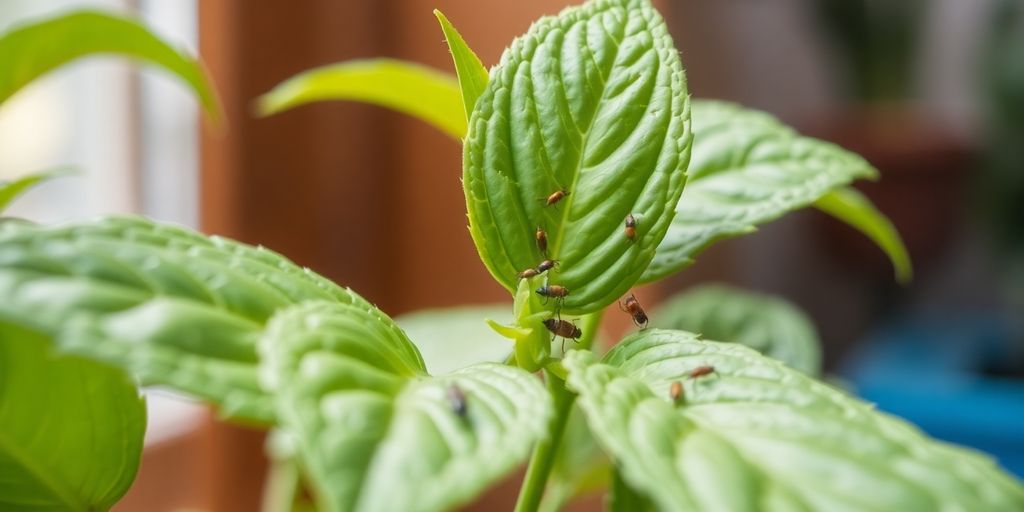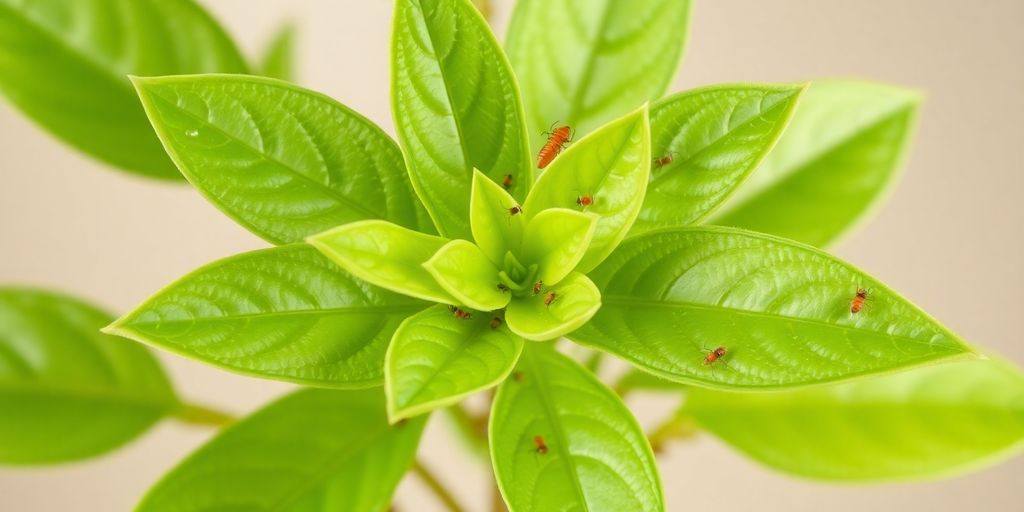Indoor plants can brighten up your space, but they can also attract pests that might ruin your green friends. Knowing how to identify and treat pests on indoor plants is essential for keeping them healthy and thriving.
This guide will walk you through some practical steps to manage pests effectively, ensuring your plants stay beautiful and pest-free.
- Regularly inspect your plants for any signs of pests.
- Keeping plants healthy through proper care reduces the chance of pest problems.
- Use simple methods like washing leaves or sticky traps to manage pests.
How to manage insects on indoor plants

Okay, so you’ve got some unwanted guests munching on your precious plants? Don’t worry, it happens to the best of us. I’ve definitely been there, staring at a plant covered in… something. Here’s what I usually do to kick those pests to the curb.
Wash leaves
This is usually my first line of defense. A good leaf washing can dislodge a surprising number of pests. Plus, it makes your plants look all shiny and happy. Here’s the lowdown:
- Wipe each leaf with a damp paper towel. Make sure you’re swapping out those towels frequently, you don’t want to just move the pests around.
- For smaller plants, give them a shower in the sink. A gentle spray works wonders.
- Larger plants can get a proper shower in the, well, shower! Just be careful with the water pressure; you don’t want to damage the plant.
Physically remove pests
Sometimes, you just gotta get your hands dirty. I know, it’s not the most glamorous task, but it’s effective. Think of it as a spa day for your plants, but you’re the masseuse, and the pests are… well, not getting a massage.
- If you spot any big guys like earwigs or caterpillars, just pluck them off. Gloves are optional, but I usually wear them. Just feels cleaner, you know?
- Scale insects can be a pain. I’ve found that a fingernail file or something similar works well to gently scrape them off. Patience is key here.
- Mealybugs are those cotton-like pests. A cotton swab dipped in alcohol is my go-to. Dab them directly, and they’ll be gone in no time.
- And sometimes, a strong blast of water is all you need to send those little buggers flying. Just be sure to check the plant again later, as they might try to come back.
Healthy plants have fewer pest problems

You know, I’ve noticed over the years that a little TLC goes a long way in keeping pests away from my indoor jungle. It’s like they can sense a weak plant from a mile away. So, let’s talk about how to keep your green buddies strong and healthy, making them less appealing to unwanted guests.
Grow plants in the best possible conditions
Matching your plant to the right environment is super important. Think about it – a cactus isn’t going to thrive in a dark, damp corner, and a fern won’t be happy baking in direct sunlight. It’s all about finding the sweet spot where they can flourish. When plants are struggling with too little light, or soil that’s too wet or too dry, they’re basically waving a flag for pests to come on over. I always try to research a plant’s needs before bringing it home. Here’s a quick checklist:
- Light: Does it need bright, indirect light, or can it handle direct sun?
- Humidity: Some plants love a humid environment, while others prefer it dry.
- Temperature: Keep an eye on those drafts and sudden temperature changes.
Water plants properly
Watering seems simple, but it’s where a lot of folks go wrong. Overwatering can lead to root rot, which weakens the plant and makes it an easy target for pests. Underwatering stresses the plant, making it just as vulnerable. I’ve learned to check the soil moisture before watering – stick your finger in an inch or two. If it feels dry, it’s time to water. If it’s still damp, hold off. It’s also a good idea to:
- Use pots with drainage holes to prevent water from sitting at the bottom.
- Water deeply, so the entire root ball gets a good soak.
- Adjust your watering schedule based on the season and the plant’s needs.
Early detection is key to managing pests
Honestly, catching those little buggers early is half the battle. I’ve learned this the hard way after a few infestations that felt like they came out of nowhere. Now, I’m all about being proactive. Here’s how I stay on top of things:
Inspect plants regularly
I make it a point to give my plants a good once-over every week. This involves checking not just the tops of the leaves, but also the undersides, stems, and even the soil surface. You’d be surprised where those pests can hide!
I’m looking for anything out of the ordinary – discoloration, spots, webbing, or the pests themselves. Sometimes, you might need a magnifying glass, especially for the really tiny critters. It’s like being a plant detective, and trust me, it pays off.
Use sticky traps for detection
I swear by sticky traps, especially those yellow ones. They’re super helpful for catching flying insects like fungus gnats, whiteflies, and even winged aphids before they become a major problem. I just stick them in the soil near my plants, and they do their thing.
It’s a simple, low-effort way to keep an eye on what’s buzzing around my indoor garden. Plus, it gives me a little peace of mind knowing I’m catching potential problems early. It’s like having a silent, sticky security guard for my plants!
Wrapping It Up: Keeping Your Indoor Plants Pest-Free
So, there you have it! Identifying and treating pests on your indoor plants doesn’t have to be a huge headache. Just keep an eye on your plants and act quickly if you spot any trouble. Regular checks and good care can really help keep those pesky bugs at bay.
Remember, it’s all about creating a healthy environment for your plants. If you stay on top of things, you’ll enjoy your green friends for a long time. And hey, if you ever feel stuck, don’t hesitate to reach out for help. Happy gardening!
Frequently Asked Questions
What are some common pests found on indoor plants?
Some usual pests include spider mites, aphids, and mealybugs. They can cause damage to your plants if not dealt with quickly.
How can I tell if my plant has pests?
Look for signs like holes in leaves, sticky residue, or tiny webs. Regularly checking both the tops and undersides of leaves helps catch problems early.
What should I do if I find pests on my plants?
You can wash the leaves with water, remove pests by hand, or use sticky traps to catch flying insects. If the problem is serious, consider using insecticidal soap.
